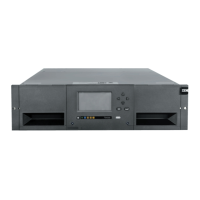• Recommendation is to perform rst load in the location of deployment, which should be in a stable
environment that meets the recommended environmental specication.
• Media optimization is a one-time operation that can be completed on any drive in the environment,
enabling the media to be used across all tape drives without further optimization.
Other considerations for media optimization:
• Media optimization averages 40 minutes per rst load of a cartridge to a tape drive. Although most
media optimizations will complete within 60 minutes some media optimizations may take up to 2 hours.
• Interruption of the process is not recommended.
• A different mount will not necessarily improve the time to complete the one-time optimization.
An update to software may be required. Contact your software application provider for more details.
Customized software, not provided as a standard market product, may require modication to ensure the
software can handle the extended rst mount time. For additional details, review the detailed section of
the IBM LTO SCSI Reference.
Recommended access order (RAO) open function
RAO enables tape control applications to accelerate the retrieval of a certain number of les from a single
tape thereby reducing the seek time between those les.
A feature of the LTO-9 full-height drives is the ability to accept a list of User Data Segments and reorder
those User Data Segments into a recommended access order that minimizes the locate portion of the
time to read those User Data Segments. This sorted list is called a Recommended Access Order (RAO)
list. A User Data Segment (UDS) is dened as a grouping of contiguous logical objects (i.e., logical blocks
and lemarks) and is described by partition number, beginning logical object identier, and ending logical
object identier.
The RAO implementation in LTO produces the best results for performance enhancement when there
is little variability in block size or data compression ratio. When the variability in compression ratio or
block sizes increase, the accuracy of the locate estimates may be reduced and any potential performance
enhancements may be diminished.
Archive mode unthread
The time that is required for an unload depends on how the cartridge has been used during the mount.
This is based on the current position and how far from the beginning of tape (BOT) the media has been
moved since mount. For details on unload performance, see “Supported tape drives” on page 10.
Speed matching
To improve system performance, the drive uses a technique that is called speed matching to dynamically
adjust its native (uncompressed) data rate to the slower data rate of a server.
With speed matching, the drive operates at different speeds when it is reading or writing the Ultrium 7 or
later cartridge format. Native data rates are shown in the table.
IBM Condential
18IBM TS4300 Tape Library Machine Type 3555: User's Guide

